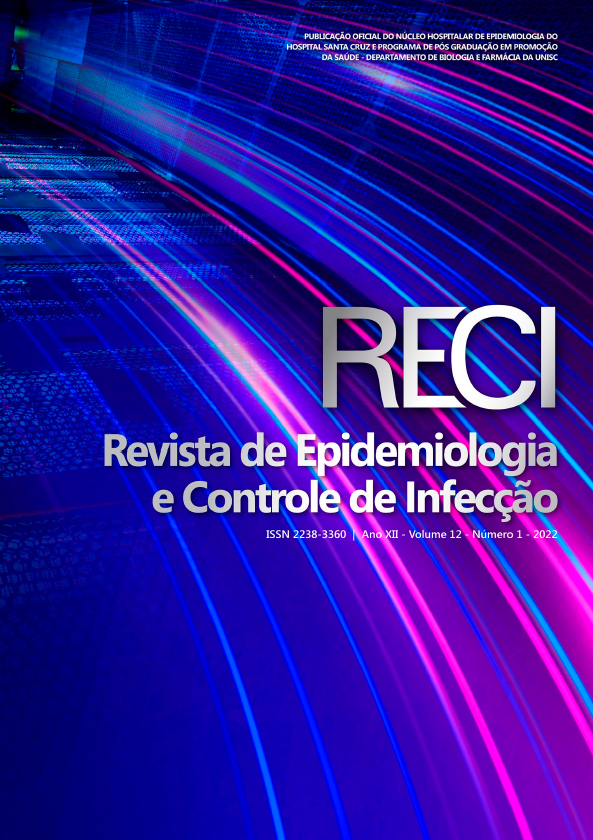Fungemia de Rhodotorula em paciente com leucemia linfoblástica aguda
DOI:
https://doi.org/10.17058/reci.v12i1.16325Palavras-chave:
Rhodotorula, Amphotericin, Acute Lymphoblastic LeukemiaResumo
Objetivos: Rhodotorula é uma levedura ambiental que pertence ao filo Basidiomycota. As espécies de Rhodotorula são onipresentes na natureza, podem ser encontradas no solo e na água doce. Pacientes imunocomprometidos podem desenvolver rodotorulose devido à ampla exposição a Rhodotorula no ambiente hospitalar. Descrição do caso: O paciente era uma criança de 3 anos de idade com diagnóstico de Leucemia Linfoblástica Aguda Pro B (LLA). O paciente deu entrada no hospital com queixas de mal-estar, cansaço, perda de peso e diarreia entre os ciclos de quimioterapia. A Rhodotorula foi isolada da hemocultura do paciente obtida durante a elevação da temperatura. Após 14 dias de tratamento com anfotericina B, a situação clínica do paciente melhorou e o paciente recebeu alta. Conclusão: Rhodotorula spp. como um patógeno raro, porém emergente, frequentemente se apresenta como febre de etiologia desconhecida resistente ao tratamento antibacteriano e pode estar associada a fungemia e outras complicações graves.
Downloads
Referências
Tournas VH, Katsoudas E, Miracco EJ. Moulds, yeasts and aerobic plate counts in ginseng supplements. Int J Food Microbiol. 2006; 108:178–81. https://doi.org/10.1016/j.ijfoodmicro.2005.11.009
Hagan ME, Klotz SA, Bartholomew W, et al. A pseudoepidemic of Rhodotorula rubra: a marker for microbial contamination of the bronchoscope. Infect Control Hosp Epidemiol. 1995; vol. 16[12]:727– 728. https://doi.org/10.1086/647048
Potenza L, Chitasombat MN, Klimko N, et al. Rhodotorula infection in haematological patient: Risk factors and outcome. Mycoses. 2019 Mar;62(3):223-229. https://doi.org/10.1111/myc.12875
Miceli MH, Díaz JA, Lee SA. Emerging opportunistic yeast infections. Lancet Infect Dis. 2011; 11[2]:142–51. https://doi.org/10.1016/S1473-3099(10)70218-8
Lunardi LW, Aquino VR, Zimerman RA, et al. Epidemiology and outcome of Rhodotorula fungemia in a tertiary care hospital. Clin Infect Dis. 2006; 43[6]:e60-3. https://doi.org/10.1086/507036
Tuon FF, Costa SF. Rhodotorula infection. A systematic review of 128 cases from literature. Rev Iberoam Micol. 2008; 25(3):135-40. https://doi.org/10.1016/s1130-1406(08)70032-9
Ioannou P, Vamvoukaki R, Samonis G. Rhodotorula species infections in humans: A systematic review. Mycoses. 2019 Feb;62(2):90-100. http://dx.doi.org/10.1111/myc.12856
Strati F, Di Paola M, Stefanini I, et al. Age and Gender Affect the Composition of Fungal Population of the Human Gastrointestinal Tract. Front Microbiol. 2016; 7:1227. https://doi.org/10.3389/fmicb.2016.01227
Wirth F, Goldani LZ. Epidemiology of Rhodotorula: an emerging pathogen. Interdiscip Perspect Infect Dis. 2012; 2012:465717. https://doi.org/10.1155/2012/465717
Gharaghani M, Taghipour S, Zarei Mahmoudabadi A. Molecular identification, biofilm formation and antifungal susceptibility of Rhodotorula spp. Mol Biol Rep. 2020 Nov;47(11):8903-8909. doi: 10.1007/s11033-020-05942-1. https://doi.org/10.1007/s11033-020-05942-1
Downloads
Publicado
Como Citar
Edição
Seção
Licença
Copyright (c) 2022 Mehmet Erinmez

Este trabalho está licenciado sob uma licença Creative Commons Attribution 4.0 International License.
The author must state that the paper is original (has not been published previously), not infringing any copyright or other ownership right involving third parties. Once the paper is submitted, the Journal reserves the right to make normative changes, such as spelling and grammar, in order to maintain the language standard, but respecting the author’s style. The published papers become ownership of RECI, considering that all the opinions expressed by the authors are their responsibility. Because we are an open access journal, we allow free use of articles in educational and scientific applications provided the source is cited under the Creative Commons CC-BY license.


